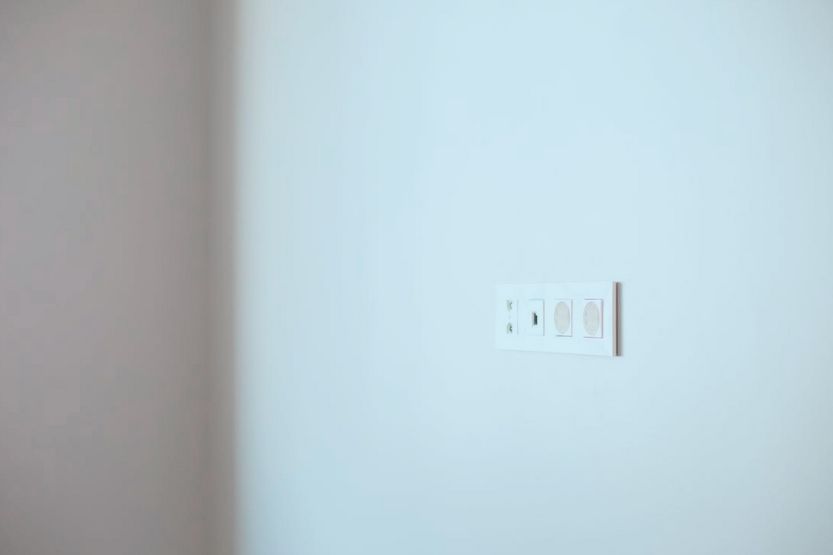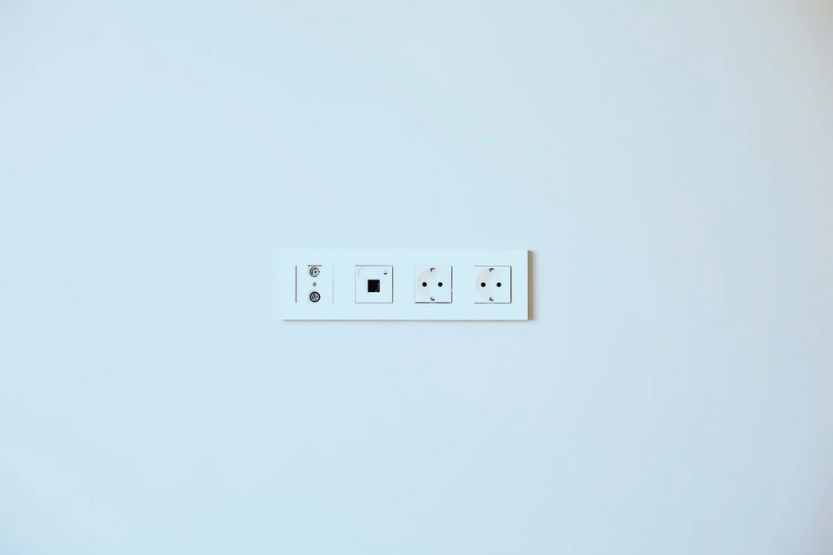Whether you’re remodeling certain areas of your home or just planning to add another outlet for a home appliance, it’s important to follow established rules for outlet height. So, what’s the standard outlet height from the floor? This article will look at everything you need to know about the standard height for electrical outlets in a home.
The average height for electrical boxes for outlets is around 12 inches from the bottom of the receptacle box to the top of the floor covering. Or it’s about 16 inches from the top of the receptacle box to the top of the floor covering.
Read on to learn more about the average height for an electrical outlet, including electrical code requirements for outlets in a home, why standard heights are essential, and much more.
Are There Standard Heights for Electrical Outlets?

The National Electrical Code (NEC), also known as NFPA 70, is the approved standard for the safe design and installation of electrical wiring and other electrical equipment.
It also establishes the basis for the clearance, height, and spacing of electrical outlets in commercial, industrial, and residential buildings.
With the help of active electrical professionals, this set of guidelines is regularly reviewed and changed to keep up with the latest improvements in safety and technology. The NEC installation code is widely used in the United States and worldwide.
As for the appropriate height of electrical outlets, NEC doesn’t have strict guidelines for it. They can be installed at a height that fits the intended use.
In most cases, NEC requires standard electrical outlets to be installed 6 feet from the floor. There should be at least 12 feet of distance between electrical outlets and 2 feet or more of unbroken wall space.
However, local and state codes still have the final say on these things; since a local government can choose to adapt and adopt model building codes as its own. So, consult your city’s municipal office for the latest and specific recommendations and guidelines.
Suggested Electrical Outlet Heights for Different Areas of the House

Now, let’s get to the point of this article. Although the National Electric Code isn’t strict about the height of electrical outlets, it doesn’t mean you or your electrician can position them anywhere. Electricians do follow commonly accepted standards when installing electrical outlets and receptacles.
The US National Electrical Code, Section 210.52, says any living space, like your bedroom, kitchen, and living room, should have at least one electrical outlet.
Let’s review the commonly used heights for electrical outlets in different home areas:
1. Basement
Most electricians will likely install an outlet 16 to 18 inches from the top of the receptacle box.
But if you’re going to measure from the basement floor to the bottom of your electrical box, the standard height is around 12 to 15 inches. Don’t install your electrical outlets less than a foot from your basement floor.
Some people, such as those with disabilities, find it more convenient if the outlet height from the floor in the basement is slightly higher.
The American Disabilities Act (ADA) recommends that homeowners position wall outlets around 15 inches above the basement floor. This is just enough height to allow people with disabilities to reach the outlets easily.
The location and number of outlets and receptacles will vary depending on how you plan to use your basement.
You can have 10 to 13 outlets on 15 amp and 20 amp circuit breakers, respectively. No minimum distance between electrical outlets rules, but you can’t have more than 6 feet (12 inches) of wall space without one.
2. Kitchen
The recommended height for a kitchen counter outlet height from the floor will depend on certain factors, like their location and purpose.
For instance, electricians usually install countertop outlets at a maximum of 18 inches (approximately 1.5 feet) high and every 4 feet (48 inches). At this height, it’s easy to reach for a plug while preventing liquid floor cleaning solutions from getting into electrical outlets.
Electrical outlets for certain home appliances will also follow a different height requirement. The best height range for a microwave electrical outlet is 66 to 75 inches.
If you’re tall (around 5’9″ in height), some suggest 75 inches as the best outlet height for a microwave outlet. There should also be a 13 to 16 inches gap between your microwave oven and cooktop.
Again, there’s no NEC code for the height of outlets in the kitchen. You can change it depending on certain conditions.
3. Bathroom
The National Electrical Code requires every bathroom to have at least one electrical outlet. As for the height, a common practice is to keep it at a minimum height of 15 inches (around 1.25 feet).
An electrical outlet should be 32 to 36 inches (2.7 to 3 feet) if it’s above a countertop, sink, or vanity. Meanwhile, the American Disabilities Act (ADA) recommends that a bathroom outlet be 15 to 48 inches (1.25 to 4 feet) above the floor.
Other things to consider:
- Don’t place an electrical outlet under a window.
- There should be an electrical outlet within 36 inches (3 feet) of the outside edge of your sink.
- The outlet should be on the wall next to a basin or countertop.
4. Garage
In a garage, installing one outlet for every car bay is essential to ensure easy charging for a parked electric car. Owners can choose whether or not their detached garage will be supplied with electric power.
Like other areas of a home, the outlet height from the floor in the garage is a matter of convenience or preference. Most contractors and electricians usually install outlets 12 to 18 inches (1 to 1.5 feet) above the floor because it’s the optimum height for most people.
Some would set them at around 48 inches (4 feet) high. Whatever height your electrician chooses, it shouldn’t be over 66 inches (5.5 feet) above the floor.
If you’re planning to use your garage as a workshop, laundry area, or storage for your appliances, you might need more outlets at different heights:
- Deep freezer: 48 inches (4 feet)
- Drill press: 30 to 36 inches (2.5 to 3 feet)
- Dust control: 15 to 20 inches (1.3 to 1.7 feet)
- Refrigerator: 48 inches (4 feet)
- Table press: 15 to 20 inches (1.3 to 1.7 feet)
- Washer and dryer: 34 to 36 inches
- Water heater: 18 inches (1.5 feet)
5. Bedroom
Technically speaking, your bedroom is just another living space in your home. As such, you can follow the standard height for wall outlets, which is around 12 to 15 inches from the top of a floor covering to the bottom of an outlet box.
However, there are a few things you need to consider when installing bedroom electrical outlets to ensure safety and convenience:
- Your bed shouldn’t be pressed against an electrical outlet. This could present a significant risk of fire and other safety issues.
- If your bedroom measures 12 feet by 14 feet, it needs to have at least 4 to 6 electrical outlets. But this depends on the available wall space.
- The best places to install electrical outlets in your bedroom are the master closet, on each side of your bed, and one on each wall.
6. Outdoor
Outdoor electrical outlets are regularly exposed to different weather elements. So, installing them according to accepted standards is critical to ensure your safety.
With that said, there’s no minimum height for outdoor electrical outlets. However, the basic height rule is they shouldn’t be over 6.5 feet above ground level.
You should also have at least one electrical outlet outside your home—one at the back and one at the front. This requirement is essential because it provides a safe way to plug your extension cord outside your home and avoid using one with an excessive length.
In addition, outdoor receptacles must have ground-fault circuit-interrupter (GFCI) protection. They must also resist tampering and withstand harsh weather conditions, especially rain and snow.
Again, what is the standard outlet height from the floor? The standard outlet height from the floor to the receptacle box’s bottom is around 12 inches or 16 inches to the top of the box.
Why Is It Important to Follow Electrical Code for Outlet Height?

The straightforward answer is yes. Why is electrical outlet height important? Below are a few reasons:
1. Avoid Creating an Eyesore
Electrical outlets and cords are necessary, but they can be unpleasant to look at. That’s why many people would prefer electrical outlets at a low height, so they can easily hide them behind furniture.
Building a home from scratch means you’ll have the luxury of hiding unpleasant-looking wires and not making outlets the room’s focal point.
Other clever ways to hide electrical outlets:
- Use screwless wall plates that can be painted or stained. They’re slightly more expensive than standard wall plates, but the clean and seamless look they offer is worth it.
- If you don’t have cabinets or other furniture to hide a power strip and outlet, try pop-up outlets that stay hidden when you’re not using them.
- Another ingenious solution is to hide outlets behind removable tile cover plates.
2. Accommodate Some Appliances
Some electrical outlets might need to be lowered or raised to maintain the appropriate height for your home appliances. The outlet height for devices depends on several factors, such as the length of the cord and where you’re going to place them.
For instance, the ideal height for a microwave outlet is between 66 and 75 inches. The top portion of your stovetop and microwave should have a clearance of 13 to 24 inches.
Microwaves can’t withstand the heat from a stove, so they shouldn’t be too close to each other. But if the height of the microwave outlet is incorrect, it would naturally be difficult to apply the ideal clearance between the two appliances.
3. Convenience
The outlet height also affects the daily life of people, especially the differently abled and older people. Putting electrical outlets too low or too high can be inconvenient.
Not only that, but it could also cause significant discomfort or worsen the condition of people with health problems (e.g., spine complications) and physical disabilities.
According to Article 210 of the National Electrical Code, there should be a minimum of two receptacle outlets that are readily accessible. This means you can reach them quickly without using a ladder, climbing over, or clearing obstacles.
4. Ensure Your Safety
This is also a safety issue, mainly when outlets are located outdoors or in areas in a home constantly exposed to moisture and water. For instance, outlets need to be higher than 15 inches in the basement to avoid damage and hazards from flooding and spills.
On the other hand, outlets can’t be raised too high because of the increased risk of tripping that power cords will pose.
Aside from placing the outlet close to the ground (but not less than the accepted minimum height), you can use a cord cover to prevent tripping and protect the power cord from damage.
5. Ease of Installation
Setting a standard for electrical outlet height makes it easier for contractors and electricians to do their job. They can do it easier and faster if they install multiple boxes along a wall because of the uniform height requirement.
Height uniformity is even more critical when they’re pulling rough-surfaced cables through studs or when cutting and putting insulation in the walls.
Conclusion – What Is the Standard Outlet Height from the Floor?
Generally, the standard height for electrical wall outlets is around 12 inches from the floor covering to the bottom of the receptacle box.
Whichever outlet height you (or your electrician) find appropriate, ensure you’re still following the industry-accepted height parameters for your safety and convenience. Also, check your local electrical code to ensure you adhere to established rules.





![Read more about the article Wiring Outlets in Series [How-to Guide]](https://homecarezen.com/wp-content/uploads/2022/08/wiring-outlets-in-series-300x200.jpg)

